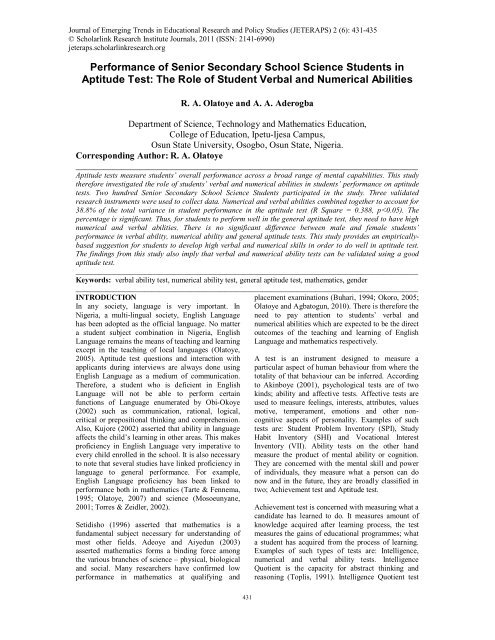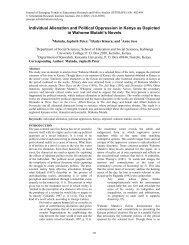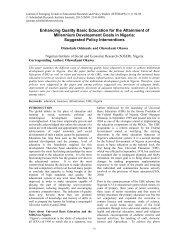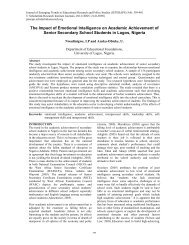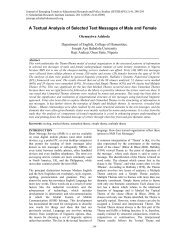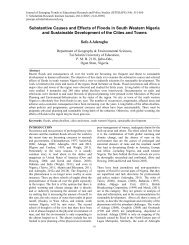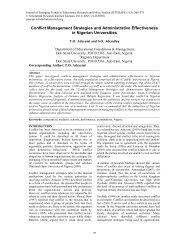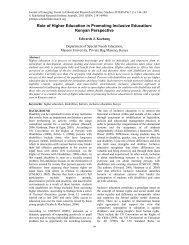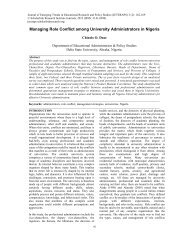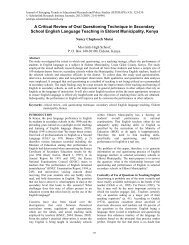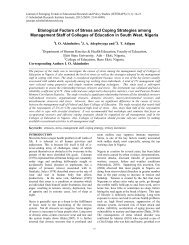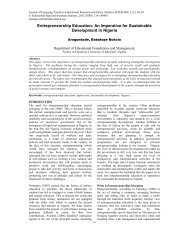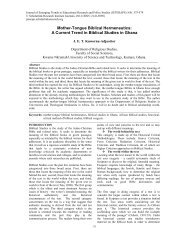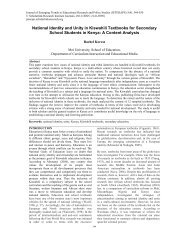Performance of Senior Secondary School Science Students in ...
Performance of Senior Secondary School Science Students in ...
Performance of Senior Secondary School Science Students in ...
Create successful ePaper yourself
Turn your PDF publications into a flip-book with our unique Google optimized e-Paper software.
Journal <strong>of</strong> Emerg<strong>in</strong>g Trends <strong>in</strong> Educational Research and Policy Studies (JETERAPS) 2 (6): 431-435<br />
Journal © Scholarl<strong>in</strong>k <strong>of</strong> Emerg<strong>in</strong>g Research Trends Institute <strong>in</strong> Educational Journals, 2011 Research (ISSN: and 2141-6990) Policy Studies (JETERAPS) 2(6):431-435 (ISSN:2141-6990)<br />
jeteraps.scholarl<strong>in</strong>kresearch.org<br />
<strong>Performance</strong> <strong>of</strong> <strong>Senior</strong> <strong>Secondary</strong> <strong>School</strong> <strong>Science</strong> <strong>Students</strong> <strong>in</strong><br />
Aptitude Test: The Role <strong>of</strong> Student Verbal and Numerical Abilities<br />
R. A. Olatoye and A. A. Aderogba<br />
Department <strong>of</strong> <strong>Science</strong>, Technology and Mathematics Education,<br />
College <strong>of</strong> Education, Ipetu-Ijesa Campus,<br />
Osun State University, Osogbo, Osun State, Nigeria.<br />
Correspond<strong>in</strong>g Author: R. A. Olatoye<br />
___________________________________________________________________________<br />
Aptitude tests measure students’ overall performance across a broad range <strong>of</strong> mental capabilities. This study<br />
therefore <strong>in</strong>vestigated the role <strong>of</strong> students’ verbal and numerical abilities <strong>in</strong> students’ performance on aptitude<br />
tests. Two hundred <strong>Senior</strong> <strong>Secondary</strong> <strong>School</strong> <strong>Science</strong> <strong>Students</strong> participated <strong>in</strong> the study. Three validated<br />
research <strong>in</strong>struments were used to collect data. Numerical and verbal abilities comb<strong>in</strong>ed together to account for<br />
38.8% <strong>of</strong> the total variance <strong>in</strong> student performance <strong>in</strong> the aptitude test (R Square = 0.388, p
Journal <strong>of</strong> Emerg<strong>in</strong>g Trends <strong>in</strong> Educational Research and Policy Studies (JETERAPS) 2(6):431-435 (ISSN:2141-6990)<br />
measures general mental ability demand<strong>in</strong>g<br />
application <strong>of</strong> knowledge <strong>in</strong> verbal and non-verbal<br />
doma<strong>in</strong>s. It is easily <strong>in</strong>fluenced by present and past<br />
environment <strong>of</strong> the candidate. Ak<strong>in</strong>boye (2001) gave<br />
the Raven’s progressive matrices, which measures<br />
general <strong>in</strong>telligence as an example <strong>of</strong> such test.<br />
Numerical ability tests are designed to measure the<br />
candidates’ capacity to manipulate or use numbers to<br />
correctly solve problems (Ann, 2004). Such tests<br />
signify basic arithmetic prowess <strong>in</strong> an <strong>in</strong>dividual.<br />
Accord<strong>in</strong>g to Nunnally (2004), it is the ability to<br />
relatively solve problems <strong>in</strong> number sequenc<strong>in</strong>g,<br />
make accurate mathematical deductions through<br />
advanced numerical reason<strong>in</strong>g, <strong>in</strong>terpret complex<br />
data presented <strong>in</strong> various graphical forms, deduce<br />
<strong>in</strong>formation and draw logical conclusions. All forms<br />
<strong>of</strong> school exam<strong>in</strong>ations <strong>in</strong> various subjects, are also<br />
broadly speak<strong>in</strong>g types <strong>of</strong> achievement test <strong>of</strong> which<br />
numerical ability test is one, It can be given directly<br />
to candidates or adm<strong>in</strong>istered as subsets <strong>of</strong> other<br />
tests. Similarly, verbal ability tests are tests used to<br />
deduce the ability <strong>of</strong> an <strong>in</strong>dividual to reason with<br />
words (Ak<strong>in</strong>boye, 2001). They <strong>in</strong>dicate the acquired<br />
capability for comprehension and communication <strong>in</strong><br />
an <strong>of</strong>ficial medium like English Language. This will<br />
require oral or written mode <strong>of</strong> response as the case<br />
may require.<br />
Aptitude tests measure the <strong>in</strong>nate, acquired or<br />
developed component <strong>of</strong> competency <strong>in</strong> knowledge,<br />
understand<strong>in</strong>g and attitude used <strong>in</strong> do<strong>in</strong>g certa<strong>in</strong> k<strong>in</strong>d<br />
<strong>of</strong> work at a particular level (Toplis, 1991). Aptitude<br />
may be physical or mental; the <strong>in</strong>nate nature <strong>of</strong><br />
aptitude is <strong>in</strong> contrast to achievement, which<br />
represents knowledge that is ga<strong>in</strong>ed through learn<strong>in</strong>g<br />
(Carr, 2004). Aptitude breaks mental ability down<br />
<strong>in</strong>to different characteristics, which are supposed to<br />
be more or less <strong>in</strong>dependent <strong>of</strong> each other; it is<br />
forward look<strong>in</strong>g as it predicts the potential for future<br />
ability to learn a skill or set <strong>of</strong> skills <strong>in</strong> a candidate.<br />
Aptitude confirms present abilities and potentials to<br />
learn and cope with new situations <strong>in</strong> the future. The<br />
difference between aptitude test and achievement test<br />
(which <strong>in</strong>clude numerical and verbal ability tests) is<br />
majorly that, while aptitude test outcomes are used as<br />
predictors <strong>of</strong> future performance, on the other hand,<br />
achievement tests are only ‘revealers’ <strong>of</strong> present<br />
performance after learn<strong>in</strong>g.<br />
Compared to achievement tests, aptitude tests cover a<br />
broader area and look at other range <strong>of</strong> experiences.<br />
Achievement tests are closely tied to particular<br />
school subjects. Aptitude tests tell us what a student<br />
br<strong>in</strong>gs to the task regardless <strong>of</strong> the specific<br />
curriculum that the student has already experienced.<br />
The difference between aptitude test and achievement<br />
tests is sometimes a matter <strong>of</strong> degree, some aptitude<br />
and achievement tests look a lot alike. Generally all<br />
tests are used for the follow<strong>in</strong>g purpose; selection,<br />
admission and certification.<br />
If the student scores <strong>in</strong> verbal and numerical ability<br />
tests significantly predict the score <strong>in</strong> aptitude test, it<br />
then means that verbal and numerical ability tests can<br />
be validated us<strong>in</strong>g a good aptitude test. This will be a<br />
significant contribution <strong>of</strong> this study to knowledge<br />
apart from provid<strong>in</strong>g empirically-based suggestion<br />
for students to develop high verbal and numerical<br />
skills <strong>in</strong> order to do well <strong>in</strong> aptitude test.<br />
Research Questions<br />
The follow<strong>in</strong>g research questions are answered <strong>in</strong> this<br />
study:<br />
1. What is the comb<strong>in</strong>ed <strong>in</strong>fluence <strong>of</strong> numerical and<br />
verbal abilities on student performance <strong>in</strong> the<br />
general aptitude test?<br />
2. What is the relative <strong>in</strong>fluence <strong>of</strong> students’ verbal<br />
ability on their performance <strong>in</strong> the general aptitude<br />
test?<br />
3. What is the relative <strong>in</strong>fluence <strong>of</strong> students’<br />
numerical ability on their performance <strong>in</strong> the general<br />
aptitude test?<br />
4. What are the relationships among students’<br />
performances <strong>in</strong> general aptitude, verbal and<br />
numerical ability tests?<br />
5. Is there any significant difference between male<br />
and female students’ performance <strong>in</strong> (i) verbal ability<br />
(ii) numerical ability and (iii) general aptitude?<br />
METHODOLOGY<br />
Design, Sampl<strong>in</strong>g Technique and Sample<br />
The design used for this research was descriptive<br />
survey. This is because data were collected on a<br />
sample <strong>of</strong> respondents, which are representative <strong>of</strong><br />
the target population. As such, the f<strong>in</strong>d<strong>in</strong>gs can be<br />
generalized on the whole population. The target<br />
population for this study was the senior secondary<br />
school science students <strong>in</strong> Ijebu Area <strong>of</strong> Ogun State,<br />
Nigeria. Five senior secondary schools were<br />
randomly selected from Ijebu Area. In each school,<br />
forty science students selected through random<br />
sampl<strong>in</strong>g participated <strong>in</strong> the study. Thus, the sample<br />
size for the study is 200. The sample comprised one<br />
hundred male and one hundred female students<br />
selected from the senior secondary II level <strong>in</strong> all the<br />
schools. The average age <strong>of</strong> students is 16.5 years.<br />
Research Instruments<br />
The <strong>in</strong>struments used were developed by the<br />
researchers. They are: Numerical Ability Test (NAT),<br />
Verbal Ability Test (VAT) and General Aptitude Test<br />
(GAT). Each <strong>of</strong> NAT, VAT and GAT conta<strong>in</strong>s thirty<br />
items. The <strong>in</strong>struments were given to experts for<br />
comments and suggestions before the f<strong>in</strong>al version<br />
was adm<strong>in</strong>istered on the respondents. The test retest<br />
reliability coefficients for NAT, VAT and GAT are<br />
0.712, 0.722 and 0.699 respectively.<br />
432
Journal <strong>of</strong> Emerg<strong>in</strong>g Trends <strong>in</strong> Educational Research and Policy Studies (JETERAPS) 2(6):431-435 (ISSN:2141-6990)<br />
METHOD OF DATA ANALYSIS<br />
Research question 1 was analysed us<strong>in</strong>g multiple<br />
regression. Research questions 2 and 3 were analysed<br />
us<strong>in</strong>g l<strong>in</strong>ear regression, research question 4 us<strong>in</strong>g<br />
Pearson product-moment correlation while t-test was<br />
used to analyze research question 5. Analyses were<br />
done at 0.05 level <strong>of</strong> confidence us<strong>in</strong>g a two-tailed<br />
test.<br />
RESULTS<br />
Research Question 1:<br />
What is the comb<strong>in</strong>ed <strong>in</strong>fluence <strong>of</strong> numerical and<br />
verbal abilities on student performance <strong>in</strong> the general<br />
aptitude test?<br />
Table 1: Numerical and verbal abilities as predictors<br />
<strong>of</strong> student general aptitude performance<br />
R = 0.623<br />
R Square = 0.388<br />
Adjusted R Square = 0.382<br />
Standard Error = 4.051<br />
Analysis <strong>of</strong> variance<br />
Sum <strong>of</strong> Df Mean F Sig. Remark<br />
square<br />
Square<br />
value<br />
Regression 2049.943 2 1024.972 62.455 0.000 *Signific<br />
ant<br />
Residual 3233.052 197 16.411 (p
Journal <strong>of</strong> Emerg<strong>in</strong>g Trends <strong>in</strong> Educational Research and Policy Studies (JETERAPS) 2(6):431-435 (ISSN:2141-6990)<br />
Table 5: Comparison <strong>of</strong> male and female student performances <strong>in</strong> verbal ability, numerical ability and general<br />
aptitude tests<br />
Variables Gender N Mean Std. dev Std. error Df T Sig. value Remark<br />
Verbal<br />
Male 100 17.800 8.295 0.830 198 -0.662 0.508 NS<br />
Ability<br />
Female 100 18.510 6.786 0.671<br />
Numerical Male 100 19.250 5.778 0.578 198 -0.352 0.725 NS<br />
Ability<br />
Female 100 19.520 5.052 0.505<br />
General<br />
Aptitude<br />
NS = Not Significant (p>0.05)<br />
Male 100 24.180 5.524 0.552 198 0.479 0.632 NS<br />
Female 100 23.380 4.774 0.447<br />
In table 5 above, there is no significant difference<br />
between male and female students’ performances <strong>in</strong><br />
verbal ability, numerical ability and general aptitude<br />
tests. Male and female students have similar levels <strong>of</strong><br />
verbal ability, numerical ability and general aptitude.<br />
DISCUSSION OF FINDINGS<br />
Consistent with previous research studies, the<br />
correlation between student performance <strong>in</strong> the<br />
aptitude test and each <strong>of</strong> the other tests (verbal and<br />
numerical tests) was significant. Drucker (1994), <strong>in</strong> a<br />
study had discovered that numerical ability will assist<br />
<strong>in</strong> hypothesiz<strong>in</strong>g relationships. This is also supported<br />
by f<strong>in</strong>d<strong>in</strong>gs <strong>in</strong> this study as performance <strong>in</strong> numerical<br />
ability translated to similar performance <strong>in</strong> verbal and<br />
general aptitude doma<strong>in</strong>s. Similarly, Bakare (1990)<br />
asserted that tra<strong>in</strong>able cognitive doma<strong>in</strong>s like<br />
numerical and verbal skills could lead to<br />
improvement <strong>in</strong> general aptitude performance<br />
consider<strong>in</strong>g that similar faculties <strong>of</strong> the bra<strong>in</strong> will<br />
determ<strong>in</strong>e performance <strong>in</strong> all ability test types like<br />
numerical and verbal tests.<br />
Though this study reported that there is no significant<br />
difference between male and female students’<br />
performances <strong>in</strong> verbal ability, numerical ability and<br />
general aptitude tests, yet gender <strong>in</strong>equality <strong>in</strong><br />
numerical ability has been widely reported. Bassey,<br />
Joshua & Asim (2004) reported that male students<br />
performed better than females <strong>in</strong> numerical ability<br />
tests. Gold<strong>in</strong>, Katz and Kuziemko (2006) showed that<br />
female high school students now outperform male<br />
students <strong>in</strong> most subjects and <strong>in</strong> particular on verbal<br />
tests. Zeidner (1986) reported that though male<br />
students performed better <strong>in</strong> general aptitude test that<br />
their female counterparts especially on quantitative<br />
subtest, the difference is not statistically significant.<br />
There is therefore the need to carry out further studies<br />
<strong>in</strong> this area. The highest positive significant<br />
relationship is between student performance <strong>in</strong> verbal<br />
and numerical ability tests. This corroborates the<br />
earlier f<strong>in</strong>d<strong>in</strong>g by Kujore (2002) that ability <strong>in</strong><br />
language affects the child’s learn<strong>in</strong>g <strong>in</strong> other areas.<br />
This makes pr<strong>of</strong>iciency <strong>in</strong> English Language very<br />
imperative to every child enrolled <strong>in</strong> the school.<br />
Several studies have l<strong>in</strong>ked pr<strong>of</strong>iciency <strong>in</strong> language<br />
to general performance. For example, English<br />
Language pr<strong>of</strong>iciency has been l<strong>in</strong>ked to performance<br />
both <strong>in</strong> mathematics (Tarte & Fennema, 1995) and<br />
science (Mosoeunyane, 2001; Torres & Zeidler,<br />
2002).<br />
Aptitude tests measure students’ overall performance<br />
across a broad range <strong>of</strong> mental capabilities. But<br />
aptitude tests also <strong>of</strong>ten <strong>in</strong>clude items which measure<br />
more specialized abilities (such as verbal and<br />
numerical skills) that predict scholastic performance<br />
<strong>in</strong> educational programmes. (Hostedware<br />
Corporation, 2004). This probably expla<strong>in</strong>s why there<br />
is high correlation between student scores <strong>in</strong> aptitude<br />
test and scores <strong>in</strong> both the verbal and numerical<br />
ability tests <strong>in</strong> this study. This f<strong>in</strong>d<strong>in</strong>g also suggests<br />
that for an aptitude test to be considered valid, it<br />
should show a significant positive correlation with<br />
both verbal and numerical tests. Aptitude tests are<br />
excellent predictors <strong>of</strong> future, scholastic achievement<br />
and provide ways <strong>of</strong> compar<strong>in</strong>g students’<br />
performance under the same situation.<br />
CONCLUSION AND RECOMMENDATIONS<br />
S<strong>in</strong>ce Aptitude performance is the potential <strong>of</strong> a<br />
person to learn effectively <strong>in</strong> future engagements, it is<br />
therefore important that schools should develop<br />
curricula that are effective <strong>in</strong> develop<strong>in</strong>g skills <strong>of</strong><br />
students <strong>in</strong> numerical and verbal doma<strong>in</strong>s as a means<br />
<strong>of</strong> improv<strong>in</strong>g performance <strong>of</strong> students <strong>in</strong> general<br />
aptitude tests. It is obvious from f<strong>in</strong>d<strong>in</strong>gs to research<br />
question four that both verbal and quantitative ability<br />
have high correlation, this relationship <strong>in</strong>dicates that<br />
one is needed for appropriate <strong>in</strong>terpretation and<br />
understand<strong>in</strong>g <strong>of</strong> other hence a balanced approach<br />
should be adopted <strong>in</strong> teach<strong>in</strong>g <strong>of</strong> both numerical and<br />
verbal skills. Student performance <strong>in</strong> all the test types<br />
considered <strong>in</strong> this study is not sensitive to gender.<br />
Therefore, gender should not be a factor to be<br />
considered when determ<strong>in</strong><strong>in</strong>g the type <strong>of</strong> assessment<br />
procedure to be employed with students. This study<br />
provides an empirically-based suggestion for the need<br />
to develop high verbal and numerical skills <strong>in</strong> order<br />
to do well <strong>in</strong> aptitude test. The f<strong>in</strong>d<strong>in</strong>gs from this<br />
study also imply that verbal and numerical ability<br />
tests can be validated us<strong>in</strong>g a good aptitude test.<br />
REFERENCES<br />
Adeoye, F.A. & Aiyedun, J.O.(2003). The Position <strong>of</strong><br />
Mathematics <strong>in</strong> the Teach<strong>in</strong>g <strong>of</strong> <strong>Science</strong> and<br />
Technology. Ibadan Journal <strong>of</strong> Educational Studies,<br />
3(1), 72-77.<br />
434
Journal <strong>of</strong> Emerg<strong>in</strong>g Trends <strong>in</strong> Educational Research and Policy Studies (JETERAPS) 2(6):431-435 (ISSN:2141-6990)<br />
Ak<strong>in</strong>boye, J.O. (2001). Concepts <strong>in</strong> Formal<br />
Education, Ibadan: University Press Limited.<br />
Ann, P. S. (2004). Measurement, Assessment and<br />
Evaluation, Lagos: Concepts Publications Limited.<br />
Bakare, C.G.M. (1990). The Cumulative Cognitive<br />
Defective Syndrome <strong>in</strong> African Children,<br />
Ibadan.:UPL.<br />
Bassey, S.W. Joshua, M.T. & Asim, A.E. (2004)<br />
Gender difference and mathematics achievement <strong>of</strong><br />
rural and senior secondary school students <strong>in</strong> Cross<br />
River State, Nigeria. Proceed<strong>in</strong>gs <strong>of</strong> epiSTEMES,<br />
Cross River State, Nigeria.<br />
Buhari,N.A.(1994).Plann<strong>in</strong>g Factors that Influence<br />
Student <strong>Performance</strong> <strong>in</strong> Mathematics.<br />
An Unpublished M.Ed Dissertation, University <strong>of</strong><br />
Ibadan, Nigeria.<br />
Carr, H.O. (2004). Education Psychology, New York:<br />
McGraw Hill Ltd.<br />
Drucker J. (1994). Cognitive Theory, London:<br />
Longman Publications.<br />
Gold<strong>in</strong>, C. L., Katz, F. & Kuziemko, I. (2006). “The<br />
Home-com<strong>in</strong>g <strong>of</strong> American College Women: The<br />
Reversal <strong>of</strong> the college Gender Gap”. Journal <strong>of</strong><br />
Economic Perspectives, 20(4): 133 – 56.<br />
Hostedware Corporation (2004). Aptitude Tests.<br />
Published by Hostedware Corporation, California,<br />
USA. Available at: www.hosted test.com/aptitudetest.html<br />
Kujore, O. (2002). Trends <strong>in</strong> Nigerian English Usage.<br />
Ibadan. Odua: Pr<strong>in</strong>t<strong>in</strong>g Press.<br />
Mosoeunyane, M.G. (2001). The Relationship<br />
between Language Scores and <strong>Science</strong> Scores <strong>of</strong> 538<br />
Junior Certificate <strong>Students</strong> <strong>in</strong> Lesotho. Available at:<br />
http/www.pentech. ac za/pil/88/abstract 30.htm<br />
Nunnally, J.O. (2004). Memory, New York:<br />
Macmillan Press.<br />
Olatoye RA (2002). A Causal Model <strong>of</strong> <strong>School</strong><br />
Factors as Determ<strong>in</strong>ants <strong>of</strong> <strong>Science</strong> Achievement <strong>in</strong><br />
Lagos State <strong>Secondary</strong> <strong>School</strong>s. An Unpublished<br />
Ph.D. Thesis, Univeristy <strong>of</strong> Ibadan, Ibadan.<br />
Olatoye,R.A. (2005). A Comparative Study <strong>of</strong><br />
Academic Achievement <strong>of</strong> <strong>Science</strong> and Non-<strong>Science</strong><br />
<strong>Students</strong> <strong>in</strong> English Language. Journal <strong>of</strong> Educational<br />
Focus. Vol. 6, 37-42. Published by Institute <strong>of</strong><br />
Education, Olabisi Onabanjo University, Ago-Iwoye,<br />
Ogun State.<br />
Olatoye, R.A. (2007). Effect <strong>of</strong> Further Mathematics<br />
on <strong>Students</strong>’ Achievement <strong>in</strong> Mathematics, Biology,<br />
Chemistry and Physics. International Journal <strong>of</strong><br />
Environmental and <strong>Science</strong> Education, 2(2), 48-53.<br />
Available on-l<strong>in</strong>e at: www.ijese.com<br />
Olatoye, R. A. & Agbatogun, A. O. (2009). Parental<br />
Involvement as a Correlate <strong>of</strong> Pupils’ Achievement <strong>in</strong><br />
Mathematics and <strong>Science</strong> <strong>in</strong> Ogun State, Nigeria.<br />
Educational Research and Review, 7, (2), 406- 411.<br />
Available on-l<strong>in</strong>e at: www.academicjournals.org/err<br />
Setidisho, N.O.H. (1996). Aims <strong>of</strong> Teach<strong>in</strong>g<br />
Mathematics. West African Journal <strong>of</strong> Education,<br />
4(3), 251-26.<br />
Tarte, L.A. & Fennema, E. (1995). Mathematics<br />
Achievement and Gender. A Longitud<strong>in</strong>al Study <strong>of</strong><br />
selected Cognitive and Affective variables (Grades 6<br />
– 12). Educational studies <strong>in</strong> mathematics, 28, 199 –<br />
227.<br />
Toplis, K. (1991). Behavioural Modification<br />
Techniques, New York: Prentice Hall Publishers.<br />
Torres, H.N. & Zeidler, D.L. (2002). The Effect <strong>of</strong><br />
English Language Pr<strong>of</strong>iciency and Scientific<br />
Reason<strong>in</strong>g Skills on the Acquisition <strong>of</strong> <strong>Science</strong><br />
Content Knowledge by Hispanic Language <strong>Students</strong>.<br />
Electronic Journal <strong>of</strong> science Education, 6(3), 567-<br />
580.<br />
Zeidner, M. (1986). Sex Differences <strong>in</strong> Scholastic<br />
Aptitude: The Israel Scene. Personality and<br />
Individual Differences. 7(6), 847 – 852.<br />
Obi-Okoye, A. F. (2002). The Place <strong>of</strong> L<strong>in</strong>guistics <strong>in</strong><br />
Second Language Teach<strong>in</strong>g / Learn<strong>in</strong>g. In: A Lawal,<br />
I.I. Abanihe, I.Ohia (Eds). Perspective <strong>in</strong> Applied<br />
L<strong>in</strong>guistics <strong>in</strong> Language and Literature, University <strong>of</strong><br />
Ibadan. P.46.<br />
Okoro, A. S.(2005).Effect <strong>of</strong> Order<strong>in</strong>g Test Itemsby<br />
Levels <strong>of</strong> Difficulty on <strong>Students</strong>’ <strong>Performance</strong> <strong>in</strong><br />
<strong>Secondary</strong> <strong>School</strong> Mathematics, Studies <strong>in</strong><br />
Curriculum, Vol. 4,Pp.68-78.<br />
435


